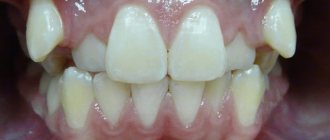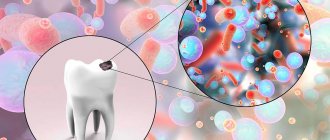The oral fluid of a healthy person is mixed saliva, which, in addition to gland secretions and gingival fluid, contains various microorganisms, as well as their waste products.
In addition, mixed saliva contains the following components:
- neutrophils, lymphocytes;
- desquamated epithelium;
- leftover food;
- protein structures (at least 17 types);
- carbohydrates;
- procoagulants.
Gingival fluid is the complex biological environment of the body, the main task of which is to maintain the health of periodontal tissues. It fills the space located between the gingival margin and the surface of the tooth. This liquid is a transudate of blood serum, its volume can vary during the day (from 0.5 to 2.4 ml).
The saliva acidity measurement scale is used to interpret the results
Important! The main function of gingival fluid is protective. Its acidity is in the range of 6.3–7.93, maintaining the Ph of mixed saliva, preventing a decrease in this indicator.
In addition, it has antimicrobial properties and provides shock-absorbing protection of the tooth from chewing load. Saliva pH is an important diagnostic indicator, since deviation of this indicator from the normal value indicates a number of serious diseases.
The pH of saliva depends on the intensity of salivation. Thus, “healthy acidity levels should fall within the range of 6.8–7.4, but with a large volume of saliva secreted they can reach 7.8 Ph. It is noteworthy that for the parotid glands the acidity value is 5.81, for the submandibular glands - 7.32 Ph.
The most informative results will be the results of measurements taken between 10 and 12 noon. Acidity assessment is carried out on an empty stomach, two hours before or after a meal. Normally, the pH of saliva decreases in the evening and at night.
The role of Ph in the body
Acid pharyngolaryngeal and gastroesophageal refluxes that reach the oral cavity play an active role in the development of “local” pathological processes. After the hydrochloric acid has reached its destination, the Ph of the mixed saliva decreases to 7.
The secretion, which normally has alkaline properties, with an acidity level of 6–6.2 causes the destruction of tooth enamel, its demineralization, which subsequently results in the appearance of carious lesions. The gums become inflamed, become swollen, turn red, and the amount of mucus on the mucous membrane increases noticeably.
Acid-base balance in the human body is an important indicator
Oxygen-rich saliva prevents the proliferation of pathogenic microflora; with low acidity, these microorganisms “bloom.” Hunger, excitement, stress, pronouncing a long monologue, breathing through the mouth - these are all the factors that lead to a decrease in Ph. This same phenomenon is associated with natural age-related changes in the body.
Acidity (pH)
Acidity
(lat.
aciditas
) - a characteristic of the activity of hydrogen ions in solutions and liquids. In medicine, the acidity of biological fluids (blood, urine, gastric juice and others) is a diagnostically important parameter of the patient’s health status. In gastroenterology, for the correct diagnosis of a number of diseases, for example, the esophagus and stomach, a one-time or even average acidity value is not significant. Most often, it is important to understand the dynamics of changes in acidity during the day (night acidity often differs from daytime) in several zones of the organ. Sometimes it is important to know the change in acidity as a reaction to certain irritants and stimulants.
Content
- pH value
- Some misconceptions
- pH value for some foods and water
- Acidity and Digestive Enzymes
- Acidity of saliva and oral cavity
- Acidity of the secretion of the pharynx and larynx
- Acidity in the esophagus
- Acidity in the stomach. High and low acidity
- Acidity in the intestines
- Stool acidity
- Blood acidity
- Acidity of urine
- Acidity of the vagina, cervical canal and uterine cavity
- Publications for healthcare professionals addressing the issue of acidity in the female genital organs
- Sperm acidity
- Skin acidity
- Acidity of other human biological fluids
- Publications for healthcare professionals addressing the issue of acidity in the digestive system
- Measures and standards of acidity
pH value
In solutions, inorganic substances: salts, acids and alkalis are separated into their constituent ions. In this case, hydrogen ions H+ are carriers of acidic properties, and OH− ions are carriers of alkaline properties. In highly dilute solutions, the acidic and alkaline properties depend on the concentrations of H+ and OH− ions. In ordinary solutions, acidic and alkaline properties depend on the activities of the aH and aOH ions, that is, on the same concentrations, but adjusted for the activity coefficient γ, which is determined experimentally. For aqueous solutions, the equilibrium equation applies: аН × аОН = Кw, where Кw is a constant, the ionic product of water (Кw = 10−14 at a water temperature of 22 °C). From this equation it follows that the activity of hydrogen ions H+ and the activity of OH− ions are interconnected. Danish biochemist S.P.L. In 1909, Sørensen proposed to show the hydrogen pH
, equal by definition to the decimal logarithm of the activity of hydrogen ions, taken with a minus (Rapoport S.I. et al.):
pH = - log (a H)
.
Based on the fact that in a neutral environment aH = aON and from the equality for pure water at 22 °C: aH× aON = Kw = 10−14, we obtain that the acidity of pure water at 22 °C (that is, neutral acidity) = 7 units pH.
Solutions and liquids with respect to their acidity are considered:
- neutral at pH = 7
- acidic at pH < 7
- alkaline at pH > 7
Some misconceptions
If one of the patients says that he has “zero acidity,” then this is nothing more than a turn of phrase, meaning, most likely, that he has a neutral acidity value (pH = 7).
In the human body, the acidity value cannot be less than 0.86 pH. It is also a common misconception that acidity values can only range from 0 to 14 pH. In technology, the acidity indicator can be negative or greater than 20. When talking about the acidity of an organ, it is important to understand that acidity can often differ significantly in different parts of the organ. The acidity of the contents in the lumen of the organ and the acidity on the surface of the mucous membrane of the organ are also often not the same. It is typical for the mucous membrane of the body of the stomach that the acidity on the surface of the mucus facing the lumen of the stomach is 1.2–1.5 pH, and on the side of the mucus facing the epithelium it is neutral (7.0 pH).
pH value for some foods and water
The table below shows the acidity values of some common foods and pure water at different temperatures:
| Product | Acidity, units pH |
| Lemon juice | 2,1 |
| Wine | 3,5 |
| Tomato juice | 4,1 |
| Orange juice | 4,2 |
| Black coffee | 5,0 |
| Pure water at 100 °C | 6,13 |
| Pure water at 50 °C | 6,63 |
| Fresh milk | 6,68 |
| Pure water at 22 °C | 7,0 |
| Pure water at 0°C | 7,48 |
Acidity and Digestive Enzymes
Many processes in the body are impossible without the participation of special proteins - enzymes, which catalyze chemical reactions in the body without undergoing chemical transformations.
The digestive process is not possible without the participation of a variety of digestive enzymes, which break down various organic food molecules and act only in a narrow range of acidity (different for each enzyme). The most important proteolytic enzymes (breaking down food proteins) of gastric juice: pepsin, gastrixin and chymosin (rennin) are produced in an inactive form - in the form of proenzymes and are later activated by hydrochloric acid of gastric juice. Pepsin is most active in a strongly acidic environment, with a pH of 1 to 2, gastrixin has maximum activity at pH 3.0–3.5, chymosin, which breaks down milk proteins into insoluble casein protein, has maximum activity at pH 3.0–3.5 . Proteolytic enzymes secreted by the pancreas and “acting” in the duodenum: trypsin has an optimum action in a slightly alkaline environment, at pH 7.8–8.0; chymotrypsin, which is close to it in functionality, is most active in an environment with an acidity of up to 8.2. The maximum activity of carboxypeptidases A and B is 7.5 pH. Similar maximum values are found for other enzymes that perform digestive functions in the slightly alkaline environment of the intestine.
Reduced or increased acidity relative to the norm in the stomach or duodenum, thus, leads to a significant decrease in the activity of certain enzymes or even their exclusion from the digestive process, and, as a consequence, to digestive problems.
Acidity of saliva and oral cavity
The acidity of saliva depends on the rate of salivation.
Typically, the acidity of mixed human saliva is 6.8–7.4 pH, but with high salivation rates it reaches 7.8 pH. The acidity of the saliva of the parotid glands is 5.81 pH, of the submandibular glands - 6.39 pH. In children, on average, the acidity of mixed saliva is 7.32 pH, in adults - 6.40 pH (Rimarchuk G.V. et al.).
Acid gastroesophageal and pharyngolaryngeal refluxes reaching the oral cavity play a leading role in the occurrence of oral pathology. As a result of the ingress of hydrochloric acid, the acidity of mixed saliva decreases below 7.0 pH. Saliva, normally enriched with calcium, phosphates, containing carbonates, sodium, potassium, magnesium and having alkaline properties, at low pH, especially at values of 6.2–6.0, leads to focal demineralization of tooth enamel with the appearance of erosions of hard dental tissues and the formation of cavities in them - caries (Novikova V.P., Shabanov A.M.).
The acidity of dental plaque depends on the condition of the hard tissues of the teeth. Being neutral in healthy teeth, it shifts to the acidic side, depending on the degree of development of caries and the age of adolescents. In 12-year-old adolescents with the initial stage of caries (precaries), the acidity of dental plaque is 6.96 ± 0.1 pH, in 12–13-year-old adolescents with average caries, the acidity of dental plaque is from 6.63 to 6.74 pH, in 16 -year-old adolescents with superficial and medium caries, the acidity of dental plaque is, respectively, 6.43 ± 0.1 pH and 6.32 ± 0.1 pH (Krivonogova L.B.).
Acidity of the secretion of the pharynx and larynx
The acidity of the secretion of the pharynx and larynx in healthy people and patients with chronic laryngitis and pharyngolaryngeal reflux is different (A.V. Lunev):
| Groups of surveyed | pH measurement location | |
| Pharynx , units pH | Larynx , units pH | |
| Healthy faces | 6,5 | 6,5 |
| Patients with chronic laryngitis without GERD | 5,6 | 5,6 |
| Patients with pharyngolaryngeal reflux | 4,9 | 4,9 |
| Patients with GERD without pharyngolaryngeal reflux | 5,2 | 5,2 |
The average pH value of the secretion of the pharynx and larynx within the groups does not have significant differences. In patients, when compared with a group of healthy individuals, the acidity of the secretions of the pharynx and larynx is higher (i.e., the pH is lower).
Acidity in the esophagus
Normal acidity in the esophagus is 6.0–7.0 pH. In addition to food and consumed liquid, the esophagus periodically receives saliva, which has neutral and slightly alkaline acidity, as well as refluxate, which is thrown from the stomach by gastroesophageal reflux. More often, refluxate has an acidity corresponding to the acidity of the stomach. Therefore, while gastric refluxate is in the esophagus, the acidity of the latter increases, the pH value decreases to 1.5–2. If there are relatively few gastroesophageal refluxes, they are considered physiological and do not affect the condition of the esophagus. Otherwise, refluxate may irritate the esophageal epithelium and develop gastroesophageal reflux disease.
The figure above shows a graph of acidity in the esophagus of a healthy person, obtained using intragastric pH-metry (Rapoport S.I.). The graph clearly shows gastroesophageal refluxes - sharp decreases in acidity to 2-3 pH, which in this case are physiological.
Acidity in the stomach. High and low acidity
The maximum observed acidity in the stomach is 0.86 pH, which corresponds to an acid production of 160 mmol/l.
The minimum acidity in the stomach is 8.3 pH, which corresponds to the acidity of a saturated solution of HCO3- ions. Normal acidity in the lumen of the body of the stomach on an empty stomach is 1.5–2.0 pH. The acidity on the surface of the epithelial layer facing the lumen of the stomach is 1.5–2.0 pH. The acidity in the depths of the epithelial layer of the stomach is about 7.0 pH. Normal acidity in the antrum of the stomach is 1.3–7.4 pH. The cause of many diseases of the digestive tract is an imbalance in the processes of acid production and acid neutralization. Long-term hypersecretion of hydrochloric acid or lack of acid neutralization, and, as a consequence, increased acidity in the stomach and/or duodenum, causes so-called acid-dependent diseases. Currently, these include: peptic ulcer of the stomach and duodenum, gastroesophageal reflux disease (GERD), erosive and ulcerative lesions of the stomach and duodenum while taking aspirin or non-steroidal anti-inflammatory drugs (NSAIDs), Zollinger-Ellison syndrome, gastritis and gastroduodenitis with high acidity and others.
Reduced acidity is observed with anacid or hypoacid gastritis or gastroduodenitis, as well as with stomach cancer. Gastritis (gastroduodenitis) is called anacid or gastritis (gastroduodenitis) with low acidity if the acidity in the body of the stomach is approximately 5 units or more. pH. The cause of low acidity is often atrophy of parietal cells in the mucous membrane or disturbances in their functions.
Above is a graph of the acidity (daily pH gram) of the body of the stomach of a healthy person (dashed line) and a patient with a duodenal ulcer (solid line). Moments of eating are marked with arrows labeled “Food”. The graph shows the acid-neutralizing effect of food, as well as increased stomach acidity with duodenal ulcer (Yakovenko A.V.).
Acidity in the intestines
Normal acidity in the duodenal bulb is 5.6–7.9 pH.
The acidity in the jejunum and ileum is neutral or slightly alkaline and ranges from 7 to 8 pH. The acidity of small intestine juice is 7.2–7.5 pH. With increased secretion it reaches 8.6 pH. The acidity of the secretion of the duodenal glands is from pH 7 to 8 pH. The acidity of colon juice is 8.5–9.0 pH.
In the lower parts of the colon, pH values of acidity gradually increase, reaching a maximum pH value in the region of the rectosigmoid junction. The following table shows the acidity in the sigmoid and rectum of a healthy person, obtained by targeted endoscopic pH-metry (Churkin I.A.):
| Measuring point | Point number in the figure | Acidity, units pH |
| Proximal sigmoid colon | 7 | 7,9±0,1 |
| Middle sigmoid colon | 6 | 7,9±0,1 |
| Distal sigmoid colon | 5 | 8,7±0,1 |
| Supraampullary rectum | 4 | 8,7±0,1 |
| Upper ampullary rectum | 3 | 8,5±0,1 |
| Mid-ampullary rectum | 2 | 7,7±0,1 |
| Inferior ampullary rectum | 1 | 7,3±0,1 |
Stool acidity
The acidity of the feces of a healthy person eating a mixed diet is determined by the vital activity of the colon microflora and is equal to 6.8–7.6 pH. Stool acidity is considered normal in the range from 6.0 to 8.0 pH. The acidity of meconium (original feces of newborns) is about 6 pH. Deviations from the norm for stool acidity:
- sharply acidic (pH less than 5.5) occurs with fermentative dyspepsia
- acidic (pH from 5.5 to 6.7) may be due to impaired absorption of fatty acids in the small intestine
- alkaline (pH from 8.0 to 8.5) may be due to the rotting of food proteins not digested in the stomach and small intestine and inflammatory exudate as a result of activation of putrefactive microflora and the formation of ammonia and other alkaline components in the large intestine
- sharply alkaline (pH more than 8.5) occurs with putrefactive dyspepsia (colitis)
Blood acidity
The acidity of human arterial blood plasma ranges from 7.37 to 7.43 pH, averaging 7.4 pH.
The acid-base balance in human blood is one of the most stable parameters, maintaining acidic and alkaline components in a certain balance within very narrow limits. Even a small shift from these limits can lead to severe pathology. When shifting to the acidic side, a condition called acidosis occurs, and to the alkaline side, alkolosis occurs. A change in blood acidity above 7.8 pH or below 6.8 pH is incompatible with life. The acidity of venous blood is 7.32–7.42 pH. The acidity of red blood cells is 7.28–7.29 pH.
Acidity of urine
In a healthy person with a normal drinking regime and a balanced diet, the acidity of urine is in the range from 5.0 to 6.0 pH, but can range from 4.5 to 8.0 pH.
The acidity of the urine of a newborn under the age of one month is normal - from 5.0 to 7.0 pH. The acidity of urine increases if a person’s diet is dominated by meat foods rich in proteins. Heavy physical work increases the acidity of urine. A dairy-vegetable diet causes urine to become slightly alkaline. Increased acidity of urine is observed with increased acidity of the stomach. Reduced acidity of gastric juice does not affect the acidity of urine. A change in urine acidity most often corresponds to a change in blood acidity. The acidity of urine changes with many diseases or conditions of the body, so determining the acidity of urine is an important diagnostic factor.
Under normal conditions, in a healthy person, the urine reaction is slightly acidic, the pH fluctuates depending on the diet between 4.5 and 8. With protein-rich foods, urine usually gives an acidic reaction, and with plant foods, an alkaline reaction. When diphosphates are released, a slightly alkaline reaction is observed. Under pathological conditions, urine can also give a strongly alkaline reaction, and in this case it is usually cloudy. With respiratory alkalosis (hyperventilation) or metabolic alkalosis, loss of acids with gastric juice, and a decrease in the amount of potassium in the blood, the urine reaction becomes alkaline. An acidic urine reaction is observed during fasting, severe diarrhea, acidosis, or after ingestion of acidifying drugs (ammonium chloride). Research is carried out only with freshly released urine. The easiest way to conduct research is with blue and red litmus paper. Acidic urine changes the litmus color from blue to red, and alkaline urine changes the litmus color from red to blue. The true reaction of urine is better determined by universal indicator paper with a range from 1-14 (Ishmanov M.Yu. et al.).
Acidity of the vagina, cervical canal and uterine cavity
The normal acidity of a woman's vagina ranges from 3.8 to 4.4 pH and averages 4.0 to 4.2 pH. Vaginal acidity in various diseases:
- cytolytic vaginosis: acidity less than 4.0 pH
- normal microflora: acidity from 4.0 to 4.5 pH
- candidal vaginitis: acidity from 4.0 to 4.5 pH
- Trichomonas colpitis: acidity from 5.0 to 6.0 pH
- bacterial vaginosis: acidity greater than 4.5 pH
- atrophic vaginitis: acidity greater than 6.0 pH
- aerobic vaginitis: acidity greater than 6.5 pH
Lactobacilli (lactobacillus) and, to a lesser extent, other representatives of normal microflora are responsible for maintaining an acidic environment and suppressing the growth of opportunistic microorganisms in the vagina.
In the treatment of many gynecological diseases, restoration of the lactobacilli population and normal acidity comes to the fore. According to Ivshin V.G. et al. (2020) in the area of the external pharynx the environment is acidic: pH = 6.42 ± 0.026. Along the course of the cervical canal, the pH value gradually increases. In the area of the internal pharynx, the pH value approaches neutral: 6.96 ± 0.013. As the sensor moves into the uterine cavity, a gradual increase in pH is observed from 7.14 ± 0.11 to 7.19 ± 0.11. On the mucous membrane of the uterine fundus, the environment is slightly alkaline: pH = 7.22 ± 0.007.
Publications for healthcare professionals addressing the issue of acidity in the female genital organs
- Murtazina Z.A., Yashchuk G.A., Galimov R.R., Dautova L.A., Tsvetkova A.V. Office diagnostics of bacterial vaginosis using hardware topographic pH-metry. Russian Bulletin of Obstetrician-Gynecologist. 2017;17(4): 54-58.
- Yashchuk A.G., Galimov R.R., Murtazina Z.A. A method for express diagnostics of disorders of vaginal biocenosis using hardware topographic pH-metry. Patent RU 2651037 C1.
- Gasanova M.K. Modern approaches to the diagnosis and treatment of serozometra in postmenopause. Abstract of dissertation. PhD, 14.00.01 - obstetrics and gynecology. RMAPO, Moscow, 2008.
Sperm acidity
The normal acidity level of sperm is between 7.2 and 8.0 pH. Deviations from these values are not in themselves considered pathology. At the same time, in combination with other deviations, it may indicate the presence of a disease. An increase in the pH level of sperm occurs during an infectious process. A sharply alkaline reaction of sperm (acidity approximately 9.0–10.0 pH) indicates prostate pathology. When the excretory ducts of both seminal vesicles are blocked, an acidic reaction of the sperm is observed (acidity 6.0–6.8 pH). The fertilizing ability of such sperm is reduced. In an acidic environment, sperm lose motility and die. If the acidity of the seminal fluid becomes less than 6.0 pH, the sperm completely lose their motility and die.
Skin acidity
The surface of the skin is covered with a water-lipid acid mantle
or
Marchionini mantle
, consisting of a mixture of sebum and sweat, to which organic acids are added - lactic, citric and others, formed as a result of biochemical processes occurring in the epidermis.
The acidic water-lipid mantle of the skin is the first barrier of protection against microorganisms. For most people, the normal acidity of the mantle is 3.5–6.7 pH. The bactericidal property of the skin, which gives it the ability to resist microbial invasion, is due to the acidic reaction of keratin, the peculiar chemical composition of sebum and sweat, and the presence on its surface of a protective water-lipid mantle with a high concentration of hydrogen ions. The low molecular weight fatty acids it contains, primarily glycophospholipids and free fatty acids, have a bacteriostatic effect that is selective for pathogenic microorganisms. The surface of the skin is populated by normal symbiotic microflora, capable of existing in an acidic environment: Staphylococcus epidermidis, Staphylococcus aureus, Propionibacterium acnes
and others. Some of these bacteria themselves produce lactic and other acids, contributing to the formation of the skin's acid mantle.
The upper layer of the epidermis (keratin scales) is acidic with a pH value of 5.0 to 6.0. In some skin diseases, the acidity level changes. For example, with fungal diseases the pH increases to 6, with eczema to 6.5, with acne to 7.
Acidity of other human biological fluids
The acidity of fluids inside the human body normally coincides with the acidity of the blood and ranges from 7.35 to 7.45 pH. The normal acidity of some other human biological fluids is shown in the table:
| Biological fluid | Acidity is normal, units. pH |
| Cytoplasm of cells | about 7.45 |
| A tear | from 7.3 to 7.5 |
| CSF (cerebrospinal fluid) | from 7.35 to 7.8 |
| Bile | from 8.0 to 8.5 |
| Human milk | from 6.9 to 7.5 |
| Pancreatic juice | from 7.5 to 9.0 |
| Synovial fluid (knee joint) | from 7.3 to 7.6 |
| Prostate juice | from 6.6 to 6.8 |
Publications for healthcare professionals addressing the issue of acidity in the digestive system
- Rapoport S.I., Lakshin A.A., Rakitin B.V., Trifonov M.M. pH-metry of the esophagus and stomach in diseases of the upper digestive tract / Ed. Academician of the Russian Academy of Medical Sciences F.I. Komarova. – M.: ID MEDPRACTIKA-M. — 2005. – p. 208.
- Churkin I.A. The use of targeted endoscopic pH-metry to assess the functional state of the mucous membrane of the rectum and sigmoid colon. Abstract of dissertation. PhD, 03.00.13 – physiology. ASMU, Tomsk, 2002.
- Khrustaleva E.V., Pedder V.V., Shishkina N.M., Lubyanskaya T.G. Relationship between the pH level of the mucous membrane of the oropharynx and the presence of fungal flora in patients with GERD // Medical Sciences. — 2013 — No. 6.
On the website, in the Literature section, there is a subsection “Acid-dependent gastrointestinal diseases”, containing articles for healthcare professionals on this topic.
Measures and standards of acidity
For verification and calibration of acidity measuring instruments in medicine and technology, special “acidity measures”, “buffer solutions”, and “standard titers” are produced.
They are capable of maintaining a strictly established value of the acidity of the solution, which does not change during measurements and for a certain time. For more information, see Standard Titers and Calibration Buffer Solutions. In the photo on the right: buffer solutions with pH=1.2 and pH=9.18 for calibrating pH probes.
Back to section
Importance in Dentistry
Oral dysbiosis
The pH of mixed saliva allows us to judge the degree of demineralization of free dental tissues. This biological fluid constantly maintains a neutral acid-base reaction (average value - 7.2) of the oral environment due to the proteins and phosphates it contains.
According to the results of modern research, it is the prolonged exposure of acids to the hard tissues of teeth that provokes the appearance of carious lesions. When acidity decreases, saliva retains and binds calcium atoms, which leads to demineralization of teeth. Biological fluid prevents the dissolution of enamel and ensures the diffusion of calcium and phosphorus ions.
Natural factors affecting the acid-base balance in the oral cavity
Many endo- and exogenous factors influence the acid-base balance in the oral cavity: the general condition of the human body, the severity of conditioned and unconditioned reflexes, muscle (chewing) activity, the nature of breathing, speech, food, oral microflora, hygiene products, dentures, fillings and other. The most pronounced influence in physiological conditions is the vital activity of microflora, the composition of food, the composition and rate of saliva secretion.
Raid
The acid-base balance in the oral cavity depends on the presence of plaque.
Microbial plaque forms mainly on the surfaces of teeth, artificial dentures and on the back of the tongue. Dental plaque (dental plaque) is an accumulation of microorganisms living in the oral cavity on the surface of the teeth with the inclusion of structureless substances of organic nature: proteins, lipids, carbohydrates. Among carbohydrates, dextran is an important homooligosaccharide consisting of glucose residues. Dextran has the ability to adhere (sorb) bacteria to dental plaque. Mature dental plaque in 1g contains about 2.5 • 1011 bacteria.
The main source of energy production from plaque bacteria is the processes of anaerobic breakdown of carbohydrates: lactic acid, butyric acid, propionic acid fermentation. Lactate and other organic acids produced by microbial plaque during the utilization of food carbohydrates are the main “culprits” of acidotic changes not only in the area of dental plaque, but also in the oral fluid. In plaque, there is a process of utilization of urea, which enters the oral cavity mainly with saliva. Bacterial ureases break down urea into ammonia and carbon dioxide. Ammonia, by binding protons, shifts the acid-base balance to the basic side. However, this is not enough to counteract the powerful “metabolic explosion” caused by carbohydrates.
Food
The acid-base balance in the oral cavity depends on food. Food is a destabilizer of acid-base balance. The influence of food should be considered from several aspects.
First, food contains acids and bases. Thus, fruits and juices contain a significant amount of organic acids, which cause a sharp decrease in the pH of the oral fluid (up to 4-3 units). If such a food product does not remain in the mouth for long, this change is short-lived. Longer contact can cause, for example, erosion of hard dental tissues: enamel and dentin. Some foods contain ammonium ions, urea (cheese, nuts, menthol) and are alcogenic. Typically, changes in the reaction of mixed saliva towards the alkaline side are insignificant and do not exceed pH 8.
Secondly, carbohydrates contained in food are metabolized by the microflora of dental plaque, with the formation of large amounts of organic acids, mainly lactate. The most acidogenic are mono- and disaccharides.
In descending order of acidogenicity, they can be arranged as follows: sucrose, invert sugar, glucose, fructose, maltose, galactose, lactose. The particular acidogenicity of sucrose is due to the adaptability of microorganisms to excess sucrose and is explained by its very rapid fermentation in dental plaque, a pronounced stimulating effect on the growth of dental plaque, and a high ability to stimulate the production of polysaccharides in dental plaque, in particular, polysaccharides with adhesive properties.
Thirdly, eating food and chewing it stimulate salivation and, thereby, help level out the resulting pH shifts.
Saliva
The acid-base balance in the oral cavity depends on saliva. Saliva is the main factor in leveling pH shifts in the oral cavity under physiological conditions. Its influence on this indicator is due to:
- mechanical cleaning from food debris; 1
- antimicrobial effect of lysozyme, cyanide anions, phagocytes, immunoglobulins and other components;
- the work of buffer systems: bicarbonate (provides about 80% of the buffer capacity of saliva), protein and phosphate.
The implementation of the pH-stabilizing properties of saliva significantly depends on the rate of its secretion and rheological properties (viscosity). In general, the higher the rate of salivary flow and the lower the viscosity, the greater the ability Muscle contractions associated with chewing, swallowing and speech contribute to the emptying of the salivary glands and the movement of saliva in the oral cavity, and therefore can be considered as a factor in stabilizing the acid-base balance.
Measurement methods
Litmus paper is a tool that allows you to determine the pH of saliva in the mouth both in the laboratory and at home. Such test strips can change color in the presence of alkalis and acids. The environment, accordingly, can be neutral, alkaline, acidic.
Important! Using litmus strips is very simple - just dip the strip in the desired solution for 2-3 seconds and compare the resulting shade with the scale.
How to use a litmus test strip should be read in the instructions
An acidic environment is considered when Ph is less, alkaline - more than 7. Indicator paper can have different forms, sold in the form of strips, boxes, rolls, pencil cases, tubes. It is noteworthy that universal litmus strips are used exclusively for determining Ph values over a wide range (accuracy - up to 1 unit or tenth).
Ph meter
This device allows you to measure acidity at home. It is believed that it does not have high accuracy, but it is inexpensive and convenient to use. The cost of a Ph meter depends on its characteristics. In particular, you should pay attention to the measurement range - from 0.00 to 14.00. In addition, indicators such as operating temperature, device division value, and accuracy are important. When purchasing, it is worth considering that the device must be calibrated.
What is the sequence of steps to determine the acidity of saliva, urine, blood or other liquids at home using a Ph meter:
- it is necessary to remove the protective cap at the bottom of the device body;
- turn on the device (move the slider to the right);
- immerse the Ph-meter up to the grooved mark in the liquid whose acidity is to be tested (in this case, in mixed saliva);
- read the readings after they have stabilized.
After each measurement, it is necessary to thoroughly rinse the electrode of the device with distilled water. As soon as the manipulations are completed, wipe the device dry with a napkin and put on the protective cap.
Important! To obtain reliable data, it is recommended to measure the acidity of saliva at least 5–8 times a day.










